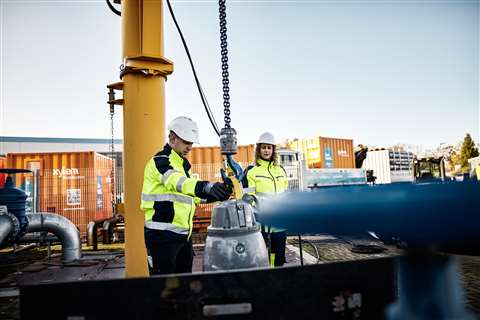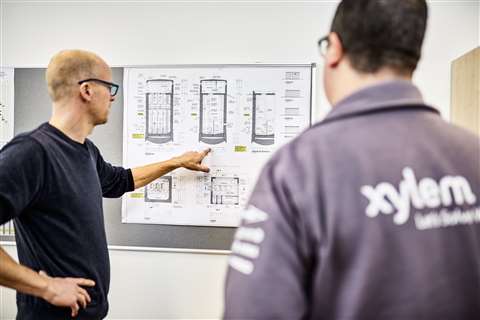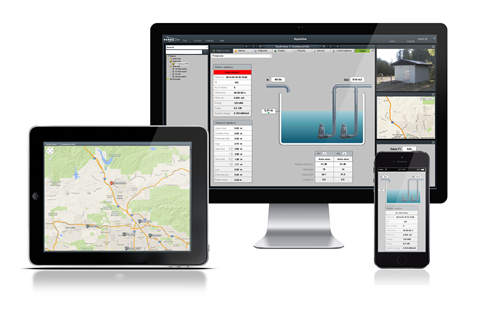Water management vital to tackle infra climate challenges
31 August 2021
Guy Fitzpatrick, Sales Director for Industry, Infrastructure & Rental at Xylem Water Solutions UK & Ireland, explains how and why water management is key to the effectiveness of infrastructure assets and looks at how rental customers can save time, energy and money by planning for a project’s pumping and water treatment equipment requirements.
We are now seeing a rising number of cases around the world where infrastructure assets are failing to protect the communities and enterprises that they are intended to serve.
 Guy Fitzpatrick, Sales Director for Industry, Infrastructure & Rental at Xylem Water Solutions UK & Ireland
Guy Fitzpatrick, Sales Director for Industry, Infrastructure & Rental at Xylem Water Solutions UK & Ireland
With investment costs running into the trillions and current predictions indicating that it will take decades to address the world’s existing infrastructure challenges, there is now an urgent need for countries to make urban infrastructure more climate resilient - which is essential to preventing further failure, both in general life and as a result of hazard or disaster events.
If organisations (and indeed governments) are to respond quickly, a level of built-in agility is needed that will allow them to adapt rapidly to the road ahead - particularly when it comes to water management.
From the perspective of water technology and pump specialist Xylem, the need for built-in agility is demonstrated by two emerging trends in its customer base:
- Customers who want rapid access to support (online support, remote support, quick access to reliable first- and second-line support) to manage existing assets.
- Customers who want a business partnership with experts so they can access specialist expertise and build bespoke solutions that bridge to new technologies in their sector
These trends, which are also reflect in Xylem’s customer satisfaction benchmarks, show that proactive asset management is not just about ensuring the right solutions and systems are incorporated into infrastructure assets, it is also about ensuring expert resources and insight are in the right place at the right time, no matter what.
The benefits of renting water pumps
Buying auxiliary equipment for short-term projects can strain budgets by tying up critical capital. Plus, there are the associated costs for equipment maintenance, spare parts, service, storage and administration.
This means that the ‘quick fix’ or rapid response services offered by rental companies are often a popular choice on projects of all sizes.
Whether looking to address an emergency breakdown or to upgrade critical water infrastructure equipment, the hire of pumping and treatment equipment can be the best option. Especially where companies that rent out equipment are also OEMs of class-leading equipment across the water cycle.

This means they can bring world-class design expertise to a variety of industries to provide cost-effective, reliable, innovative solutions to even the most challenging problems impacting their water footprint.
Thus, hirers gain the most effective technical equipment, plus experienced help and insight.
Rental services also provide an attractive alternative for emergency, temporary bypass or semi-permanent pumping of water and wastewater.
Rental pumps, for example, can provide exceptional value for lowering water tables, dewatering groundwater, or draining storm waters from sites. Fleet can be available for use as consignment stock or for 24/7 contingency planning.
Experienced engineers can help solve tough challenges – from draining to complete fluid transfers – the right way from the start.
Rental banks can also provide instant access to a wide range of standardised assets. For example, Xylem’s own rental banks across Europe can rapidly deploy products, field engineers and solutions to support any project in a given locality.
Extending asset lifespans
While Xylem has also developed Treatment Rental as another option to aid customers needing shorter term solutions, for those looking to buy new pumping equipment however, the emphasis must be on effectiveness. This means investing in quality.
In addition, there is also a need to ‘do more with less’, to limit consumption and optimise what we already have.
From design to installation and commissioning, steps can be taken to keep the life cycle costs of an asset low, and this starts with specifying the right product for the job.
General Motors, for example, acknowledging its responsibility to environmental stewardship, recently announced plans to reduce the water intensity of its operations by 35% by 2035, compared to its 2010 baseline, by seeking new ways to drive resource efficiency and implement new solutions.
Proactive asset management
The correct design approach and an optimal asset management strategy, requires deeper insights into the impacts and real costs of operation, and the true cost of risk across the business.
This is reflected in corporate reporting, which now includes how environmental factors impact infrastructure assets.
For example, as global climate patterns cause more intense rainfall and pronounced droughts, operations become significantly impacted as a result of erratic water resources. This in turn challenges every stage of an asset’s life cycle.

With smart water management, implementing energy-efficient measures at the operational stage can save up to 50% of usage and costs, while remote monitoring options and other technological solutions can keep subsequent maintenance costs – and related staffing – low.
A closer look at each stage in the life cycle of an asset reveals how our infrastructure can save energy, time and costs, and become more resilient and sustainable.
Water management: How to plan for the lifespan of an asset
The design stage
The life cycle of an asset begins at the design stage, making it critical to build in efficiencies from this phase onwards; it is here that decision intelligence can bring long-term cost savings.
For example, space is often the greatest challenge to pump station design in developed urban areas. Specific features – like baffle walls, flow guiding channels or formed suction intakes for axial flow pumps - can help maximise efficiency in a minimal amount of space.
Sizing decisions can have lasting repercussions: large pumps tend to be customised and can be particularly efficient, whereas small pumps can operate in a wide range of scenarios and adapt more easily to varying flow conditions.
Both submersible and dry-installed pumps have advantages and disadvantages, mostly related to maintenance and the flexibility they bring to the station.
When Xylem designed and equipped a new pump station for Dubai International Airport to collect rain and stormwater run-off and pump it to a dedicated location for storage, Flygt pumps were selected for their consistent performance, as evidenced across a range of projects including existing airport installations.
The stormwater management solution included five large submersible centrifugal pumps with 400kW motors to help support the smooth running of runway and ground infrastructure, and ensure the seamless take-off and landing of aircrafts while maintaining compliance with local regulations.
The operation stage: How to increase the energy efficiency of infrastructure assets
Solutions exist to boost energy efficiency of assets in operation by as much as 50% within a range with the use of intelligent equipment capable of sensing its environment and adjusting accordingly.
When tasked with tackling energy consumption by Heathrow Airport’s Water Services Section, where waste management is a vital issue, Xylem used intelligent equipment to achieve significant cost reductions.
In a localised trial to reduce energy bills for the cargo area, two Flygt Experior Adaptive N submersible sewage pumps were installed along with two SmartRun intelligent pump controllers, which reduce a pump’s speed on every pump cycle until the minimum specific energy is found.
Three years on, the pumps are still running at their optimum efficiency, and will have cut energy consumption by 50% over a five-year period at just one pumping station.
As a result, running costs have dropped from £2,300 (€2,680) per year to under £300 (€394) and maintenance time - previously 21 hours a year - reduced to just four hours annually.
The Experior solution mentioned above of Flygt adaptive N submersible sewage pump and separate Smartrun VFD (Variable Frequency Drive) intelligent controller, have been combined into the Concertor pump offering a smaller footprint for installation, along with a number of other benefits to the user.
The maintenance stage
 The Flygt AquaView system records and reports asset performance and runtimes.
The Flygt AquaView system records and reports asset performance and runtimes.
Remote monitoring and control allow corporations to measure performance and take corrective action to ensure any system (for example a pumping system) is achieving its short-term and long-term objectives.
By providing an accurate overview of performance, incidents can be prevented, and costly downtime averted.
Xylem worked with Transport for London in a project to keep tunnels and stations free from excess water that could disrupt London’s tube network.
The project saw almost 170 Flygt fluid monitoring and control pump controller units placed at strategic points around the 253-mile network to gather critical data to determine when individual pumps needed to be employed to prevent water rising.
In the past, technicians had lost time travelling to maintain assets according to a rota often interrupted by alarms and emergency service calls - this was replaced by planned service and maintenance, thanks to the Flygt AquaView system recording and reporting asset performance and runtimes.
This issue of unplanned maintenance which can dictate staffing levels and cause costs to escalate over an asset’s life cycle, when back-up is constantly needed, is a critical issue.
The historic Scottish town of St. Andrews reduced energy costs by more than 23%, and eliminated weeks of man-hours spent on nuisance call-outs and minimised both operational and capital expenditures after installing Flygt MultiSmart Intelligent Pump Station Manager at its existing terminal pump station.
Erratic supply voltage fluctuations had resulted in constant call-outs of operational staff for pump resets, but after the unit had been retrofitted an examination of the integrated event and fault logs showed on average four events per week during the trial were detected and resolved by the new system.
Preventative maintenance planning
Investing in quality and limiting consumption where possible is critical for the bottom line, enabling re-investment to further secure the life of the asset to the benefit of the communities and enterprises it serves.
Planned and preventative maintenance contracts can be the eyes and ears of the engineer, avoiding the hidden long-term costs of reactive maintenance; better planned maintenance also allows staff to focus elsewhere, meaning further savings can be made.
Intelligent hardware can do the heavy lifting; investing in expertise and implementing decision intelligence at each phase can help to optimise the entire life cycle, from the design stage to operational cost savings. That way - doing more with less - you learn to let your assets work for you, rather than the other way around.
STAY CONNECTED


Receive the information you need when you need it through our world-leading magazines, newsletters and daily briefings.



